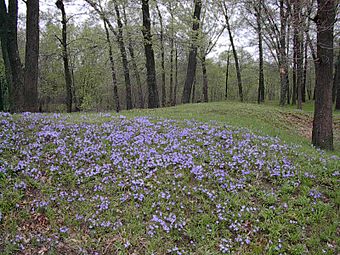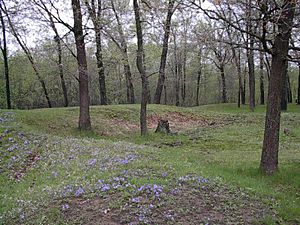Gee's Slough Mound Group facts for kids
Quick facts for kids |
|
|
Gee's Slough Mound Group
|
|

This form is reportedly the Water Panther
|
|
| Lua error in Module:Location_map at line 420: attempt to index field 'wikibase' (a nil value). | |
| Location | Address restricted |
|---|---|
| Nearest city | New Lisbon, Wisconsin |
| Area | 2 acres (0.81 ha) |
| Built | 0300 |
| NRHP reference No. | 78000108 |
| Added to NRHP | March 8, 1978 |
The Gee's Slough Group is a collection of ancient Indian Mounds located near New Lisbon, Wisconsin. These mounds are found along the Lemonweir River and are listed on the US National Register of Historic Places. This area was a popular winter gathering spot for the Woodland Culture Indians. These people are thought to be the ancestors of the Ho-Chunk (Winnebago) tribe.
Contents
What Are the Gee's Slough Mounds?
The Gee's Slough Group includes several types of mounds. You can find three round, cone-shaped mounds (called conical mounds). There are also two long, straight mounds (linear mounds) and one chain mound. A special mound shaped like a panther is also part of the group. Some people believe this panther shape represents a water spirit. In the past, there were at least seven more mounds here, but they have been destroyed over time.
Conical Mounds: Ancient Burial Sites
Conical mounds are round, cone-shaped hills. They can be small, just a few meters wide, or very large, over 20 meters across. The first conical mounds in Wisconsin were built by Woodland tradition cultures as early as 400 BC.
These mounds were usually built as places to bury the dead. They might have served as tombs for families or important groups of people. Different groups built these mounds during various times:
- The Early Woodland stage (500–100 BC)
- The Middle Woodland stage (100 BC–AD 500)
- The Late Woodland stage (AD 500–AD 1300)
Middle Woodland Culture and Trade
During the Middle Woodland stage, the people who built mounds were very active in trade. They exchanged goods over long distances. They got materials from places as far away as the Gulf Coast of Mexico and the Great Plains. This shows they had connections with many other groups.
These cultures also started to experiment with horticulture, which is like early gardening. They grew different kinds of plants, some native to the area and some brought from places like Mesoamerica.
Late Woodland Life and Effigy Mounds
By the Late Woodland stage, the big trade networks from earlier times became less active. People in the southern part of Wisconsin mainly ate corn, beans, and squash that they grew. They also hunted and gathered food. In the northern part of the state, people mostly relied on hunting and gathering.
During this period, mound builders started creating special mounds called effigy mounds. These mounds were shaped like animals, such as the panther at Gee's Slough. They were also used for burying the dead.


